Demand Flexibility of Pre-Cooling Strategies for City-Scale Buildings Through Urban Building Energy Modeling
Abstract
1. Introduction
- (1)
- Exploring the factors related to indoor temperature changes and thermostat settings and how to develop reasonable and relatively effective pre-cooling strategies with temperature reset based on electricity pricing rules.
- (2)
- Combining EnergyPlus with AutoBPS to achieve more efficient and rapid establishment of DR models and obtain energy consumption results.
- (3)
- Expanding the simulation from individual buildings to the entire building cluster. To explore the pre-cooling implementation effects on different districts and finally summarize the DR potential of the entire building cluster, which has reference value for architectural design and urban construction.
- (4)
- Exploring the effect of peak shaving and valley filling based on electricity bills and evaluation indicators, achieving quantitative evaluation of energy flexibility, and thereby providing constructive suggestions for control optimization of HVAC systems.
2. Method
2.1. Investigation of ToU Price
2.2. Case Study Buildings
2.2.1. Individual Building
2.2.2. Building Cluster
2.3. DR Control Strategies
2.3.1. Pre-Cooling
2.3.2. Temperature Reset
2.3.3. Rule-Based Strategies
2.4. Building Simulation Tool
2.4.1. Urban Building Energy Modeling (UBEM)
2.4.2. Energy Consumption Calculation
2.5. Simulation Scenarios
2.5.1. Baseline Model
2.5.2. Pre-Cooling Model
2.6. Evaluation Metrics
2.6.1. Peak Power Reduction and Percentage
2.6.2. Cost Saving
2.6.3. Flexibility Index (FI)
3. Results
3.1. Results of Individual Buildings
3.1.1. Detailed Results of Two Individual Buildings
3.1.2. Power Reduction Effect of All Prototype Buildings
3.2. DR Potential of Pre-Cooling on Shenzhen Building Cluster
3.2.1. Electricity Demand Difference of Building Cluster
3.2.2. DR Potential of Different Districts and Overall Analysis
4. Discussions
- (1)
- When formulating the pre-cooling strategies, this article set the same temperature variation for all types of rooms, but in fact, rooms at different locations and floors are affected differently by the external environment, and their sensitivity to temperature varies, resulting in different indoor temperature changes. Therefore, in future research, it is necessary to consider controlling the temperature setpoint for different types of rooms separately.
- (2)
- The simulation results of this article show that after 1.5 h of pre-cooling, the cooling capacity of the internal structure of buildings is already saturated, so increasing the cooling time to 1 h will not release more cooling capacity during DR time. This involves the issue of internal thermal mass in buildings, and how to rely on the concept to improve pre-cooling potential is something that needs to be considered in future research.
- (3)
- The cost saving effect of pre-cooling essentially depends on the structure of electricity price rates. However, our current research is based on static electricity prices, pursuing a greater difference in peak and valley electricity prices. In the future, we need to expand to dynamic electricity prices abroad and conduct exploration of DR potential and evaluation of energy flexibility.
5. Conclusions
- (1)
- Through detailed analysis of the individual buildings’ simulation results, it is found that 0.5 h is the most suitable pre-cooling duration for the simulation in this study. In order to achieve a better DR effect without affecting thermal comfort, temperature reset was combined with the flexible operation with a temperature rise of 2 °C, thus forming the optimal pre-cooling strategy.
- (2)
- The implementation of a pre-cooling strategy is more effective for small buildings because it is more controllable. Commercial buildings have better pre-cooling effects than residential buildings because during the duration of DR strategies implementation, the occupancy rate of commercial buildings is higher.
- (3)
- Guangming District has shown the best results in peak electricity reduction and cost saving among the nine districts in Shenzhen. Under the optimal pre-cooling strategy, the total electricity consumption reduction of the entire Shenzhen building cluster during peak hours is 38,371.23 MW, with the total electricity cost saving of approximately CNY 99.69 million. This indicates that the impact of pre-cooling on the entire building cluster is enormous.
Author Contributions
Funding
Data Availability Statement
Acknowledgments
Conflicts of Interest
References
- Wang, J.; Wei, Z.; Zhu, Y.; Zheng, C.; Li, B.; Zhai, X. Demand Response via Optimal Pre-Cooling Combined with Temperature Reset Strategy for Air Conditioning System: A Case Study of Office Building. Energy 2023, 282, 128751. [Google Scholar] [CrossRef]
- Lund, P.D.; Lindgren, J.; Mikkola, J.; Salpakari, J. Review of Energy System Flexibility Measures to Enable High Levels of Variable Renewable Electricity. Renew. Sustain. Energy Rev. 2015, 45, 785–807. [Google Scholar]
- Ahrari, M.; Shirini, K.; Gharehveran, S.S.; Ahsaee, M.G.; Haidari, S.; Anvari, P. A Security-Constrained Robust Optimization for Energy Management of Active Distribution Networks with Presence of Energy Storage and Demand Flexibility. J. Energy Storage 2024, 84, 111024. [Google Scholar] [CrossRef]
- Shan, K.; Wang, S.; Yan, C.; Xiao, F. Building Demand Response and Control Methods for Smart Grids: A Review. Sci. Technol. Built Environ. 2016, 22, 692–704. [Google Scholar] [CrossRef]
- Peng, C.; Chen, Z.; Yang, J.; Liu, Z.; Yan, D.; Chen, Y. Assessment of Electricity Consumption Reduction Potential for City-Scale Buildings Under Different Demand Response Strategies. Energy Build. 2023, 297, 113473. [Google Scholar] [CrossRef]
- Jiang, Y.; Andrew Ejenakevwe, K.; Wang, J.; Tang, C.Y.; Song, L. Development, Implementation, and Impact Analysis of Model Predictive Control-Based Optimal Precooling Using Smart Home Thermostats. Energy Build. 2024, 303. [Google Scholar] [CrossRef]
- Kishore, R.A.; Bianchi, M.V.A.; Booten, C.; Vidal, J.; Jackson, R. Modulating Thermal Load through Lightweight Residential Building Walls Using Thermal Energy Storage and Controlled Precooling Strategy. Appl. Therm. Eng. 2020, 180, 115870. [Google Scholar] [CrossRef]
- Chen, Y.; Xu, P.; Chen, Z.; Wang, H.; Sha, H.; Ji, Y.; Zhang, Y.; Dou, Q.; Wang, S. Experimental Investigation of Demand Response Potential of Buildings: Combined Passive Thermal Mass and Active Storage. Appl. Energy 2020, 280, 115956. [Google Scholar] [CrossRef]
- Wang, J.; Tang, C.Y.; Song, L. Design and Analysis of Optimal Pre-Cooling in Residential Buildings. Energy Build. 2020, 216, 109951. [Google Scholar] [CrossRef]
- Yin, R.; Xu, P.; Piette, M.A.; Kiliccote, S. Study on Auto-DR and Pre-Cooling of Commercial Buildings with Thermal Mass in California. Energy Build. 2010, 42, 967–975. [Google Scholar] [CrossRef]
- Shan, K.; Wang, J.; Hu, M.; Gao, D.-c. A Model-Based Control Strategy to Recover Cooling Energy from Thermal Mass in Commercial Buildings. Energy 2019, 172, 958–967. [Google Scholar] [CrossRef]
- Wijesuriya, S.; Brandt, M.; Tabares-Velasco, P.C. Parametric Analysis of a Residential Building with Phase Change Material (PCM)-Enhanced Drywall, Precooling, and Variable Electric Rates in a Hot and Dry Climate. Appl. Energy 2018, 222, 497–514. [Google Scholar] [CrossRef]
- You, Z.; Sun, Y.; Mo, S.; Zou, W.; Zhang, X.; Gao, D.C. Experimental Evaluation of the Effects of Passive Phase Change Material Walls on the Building Demand Response for Smart Grid Applications. Buildings 2022, 12, 1830. [Google Scholar] [CrossRef]
- Jaradat, M.; Al Majali, H.; Bendea, C.; Bungau, C.C.; Bungau, T. Enhancing Energy Efficiency in Buildings Through PCM Integration: A Study across Different Climatic Regions. Buildings 2024, 14, 40. [Google Scholar] [CrossRef]
- Jarvinen, J.; Goldsworthy, M.; Pudney, P.; White, S.; Cirocco, L.; Bruno, F. Aggressive Pre-Cooling of an Office Building to Reduce Peak Power During Extreme Heat Days through Passive Thermal Storage. Sustain. Energy Grids Netw. 2024, 38, 101313. [Google Scholar] [CrossRef]
- Deng, Z.; Chen, Y.; Yang, J.; Causone, F. AutoBPS: A Tool for Urban Building Energy Modeling to Support Energy Efficiency Improvement at City-Scale. Energy Build. 2023, 282, 112794. [Google Scholar] [CrossRef]
- Dong, Y.; Zhang, L.; Wang, P.; Liu, Z.; Su, X.; Liao, H.; Jiang, X. Potential Evaluation of Energy Flexibility and Energy-Saving of PCM-Integrated Office Building Walls. J. Build. Eng. 2023, 79, 107857. [Google Scholar] [CrossRef]
- GB 50189–2005; Ministry of Housing and Urban-Rural Development, Design Standard for Energy Efficiency of Public Buildings. China Architecture & Building Press: Beijing, China, 2005.
- GB 50189–2015; Ministry of Housing and Urban-Rural Development, Design Standard for Energy Efficiency of Public Buildings. China Architecture & Building Press: Beijing, China, 2015.
- JGJ 134–2001; Ministry of Housing and Urban-Rural Development, Design Standard for Energy Efficiency of Residential Buildings in Hot Summer and Cold Winter Zone. China Architecture & Building Press: Beijing, China, 2001.
- JGJ 134–2010; Ministry of Housing and Urban-Rural Development, Design Standard for Energy Efficiency of Residential Buildings in Hot Summer and Cold Winter Zone. China Architecture & Building Press: Beijing, China, 2010.
- GB 55015-2021; Ministry of Housing and Urban-Rural Development, General Code for Energy Efficiency and Renewable Energy Application in Buildings. China Architecture & Building Press: Beijing, China, 2021.
- Turner, W.J.N.; Walker, I.S.; Roux, J. Peak Load Reductions: Electric Load Shifting with Mechanical Pre-Cooling of Residential Buildings with Low Thermal Mass. Energy 2015, 82, 1057–1067. [Google Scholar] [CrossRef]
- Tian, Z.; Si, B.; Wu, Y.; Zhou, X.; Shi, X. Multi-Objective Optimization Model Predictive Dispatch Precooling and Ceiling Fans in Office Buildings under Different Summer Weather Conditions. Build. Simul. 2019, 12, 999–1012. [Google Scholar] [CrossRef]
- Zhu, J.; Niu, J.; Tian, Z.; Zhou, R.; Ye, C. Rapid Quantification of Demand Response Potential of Building HAVC System via Data-Driven Model. Appl. Energy 2022, 325, 119796. [Google Scholar] [CrossRef]
- Tang, H.; Wang, S. A Model-Based Predictive Dispatch Strategy for Unlocking and Optimizing the Building Energy Flexibilities of Multiple Resources in Electricity Markets of Multiple Services. Appl. Energy 2022, 305, 117889. [Google Scholar] [CrossRef]
- Song, Z.; Shi, J.; Li, S.; Chen, Z.; Jiao, F.; Yang, W.; Zhang, Z. Data-Driven and Physical Model-Based Evaluation Method for the Achievable Demand Response Potential of Residential Consumers’ Air Conditioning Loads. Appl. Energy 2022, 307, 118017. [Google Scholar] [CrossRef]
- Naderi, S.; Heslop, S.; Chen, D.; Macgill, I.; Pignatta, G. Consumer Cost Savings, Improved Thermal Comfort, and Reduced Peak Air Conditioning Demand Through Pre-Cooling in Australian Housing. Energy Build. 2022, 271, 112172. [Google Scholar] [CrossRef]
- Song, C.; Deng, Z.; Zhao, W.; Yuan, Y.; Liu, M.; Xu, S.; Chen, Y. Developing Urban Building Energy Models for Shanghai City with Multi-Source Open Data. Sustain. Cities Soc. 2024, 106, 105425. [Google Scholar] [CrossRef]
- Crawley, D.B.; Lawrie, L.K.; Winkelmann, F.C.; Buhl, W.F.; Huang, Y.J.; Pedersen, C.O.; Strand, R.K.; Liesen, R.J.; Fisher, D.E.; Witte, M.J.; et al. EnergyPlus: Creating a New-Generation Building Energy Simulation Program. Energy Build. 2001, 33, 319–331. [Google Scholar] [CrossRef]
- Aghniaey, S.; Lawrence, T.M.; Sharpton, T.N.; Douglass, S.P.; Oliver, T.; Sutter, M. Thermal Comfort Evaluation in Campus Classrooms During Room Temperature Adjustment Corresponding to Demand Response. Build. Environ. 2019, 148, 488–497. [Google Scholar] [CrossRef]
- Reynders, G.; Amaral Lopes, R.; Marszal-Pomianowska, A.; Aelenei, D.; Martins, J.; Saelens, D. Energy Flexible Buildings: An Evaluation of Definitions and Quantification Methodologies Applied to Thermal Storage. Energy Build. 2018, 166, 372–390. [Google Scholar] [CrossRef]
- Lind, J.; Möllerström, E.; Averfalk, H.; Ottermo, F. Energy Flexibility Using the Thermal Mass of Residential Buildings. Energy Build. 2023, 301, 113698. [Google Scholar] [CrossRef]
- Jensen, S.Ø.; Marszal-Pomianowska, A.; Lollini, R.; Pasut, W.; Knotzer, A.; Engelmann, P.; Stafford, A.; Reynders, G. IEA EBC Annex 67 Energy Flexible Buildings. Energy Build. 2017, 155, 25–34. [Google Scholar] [CrossRef]
- Li, H.; Wang, Z.; Hong, T.; Piette, M.A. Energy Flexibility of Residential Buildings: A Systematic Review of Characterization and Quantification Methods and Applications. Adv. Appl. Energy 2021, 3, 100054. [Google Scholar] [CrossRef]
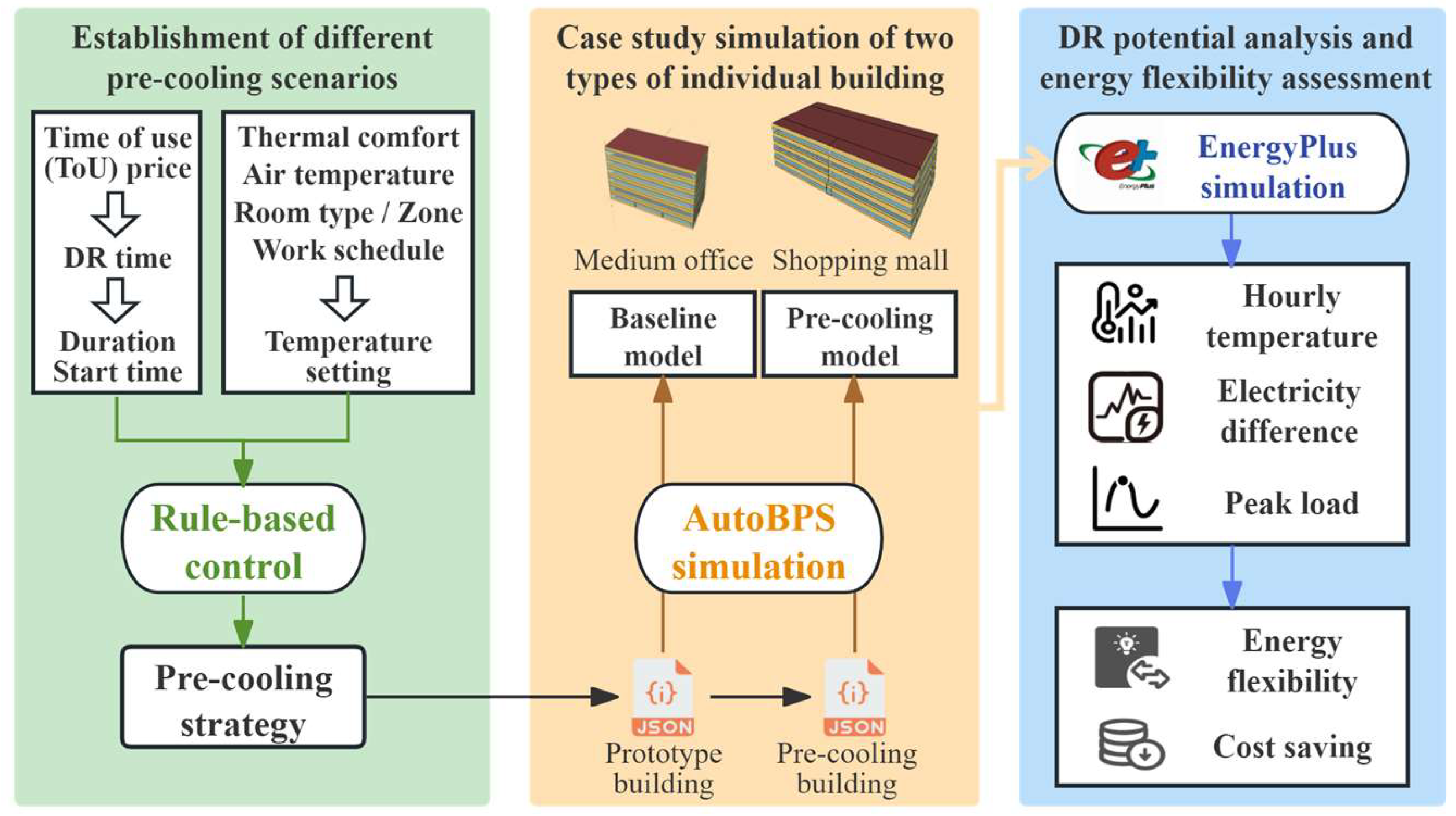
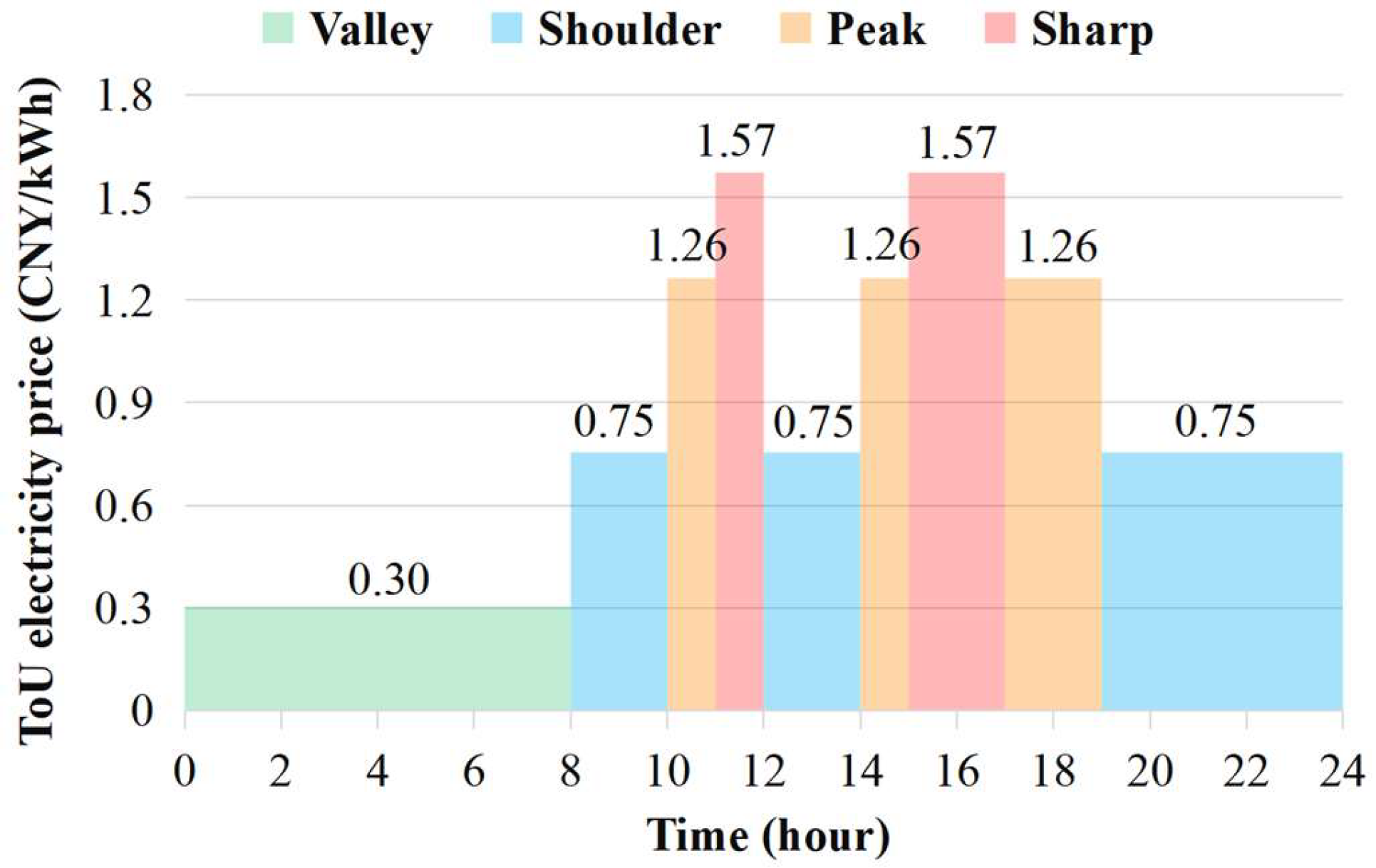

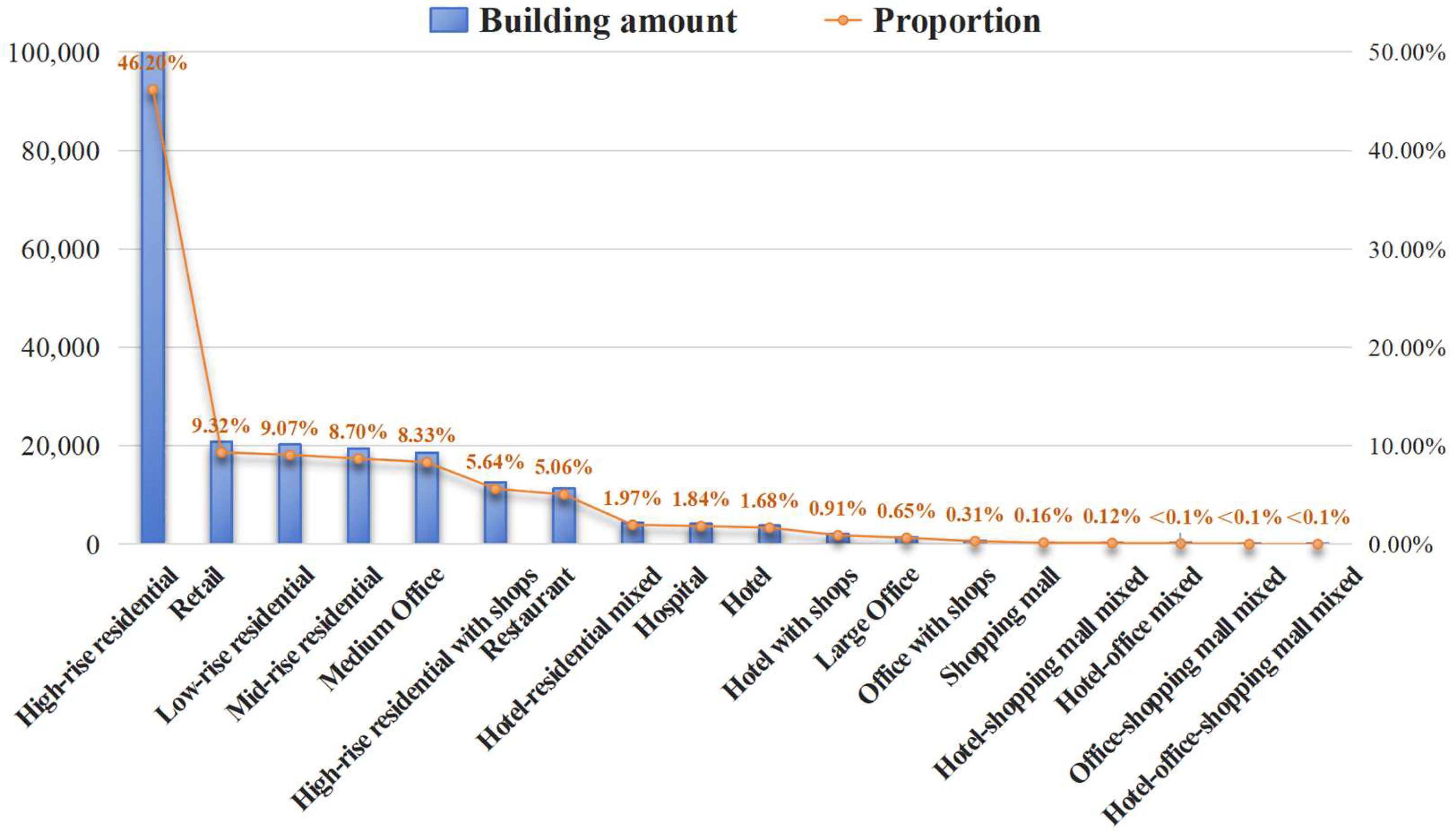
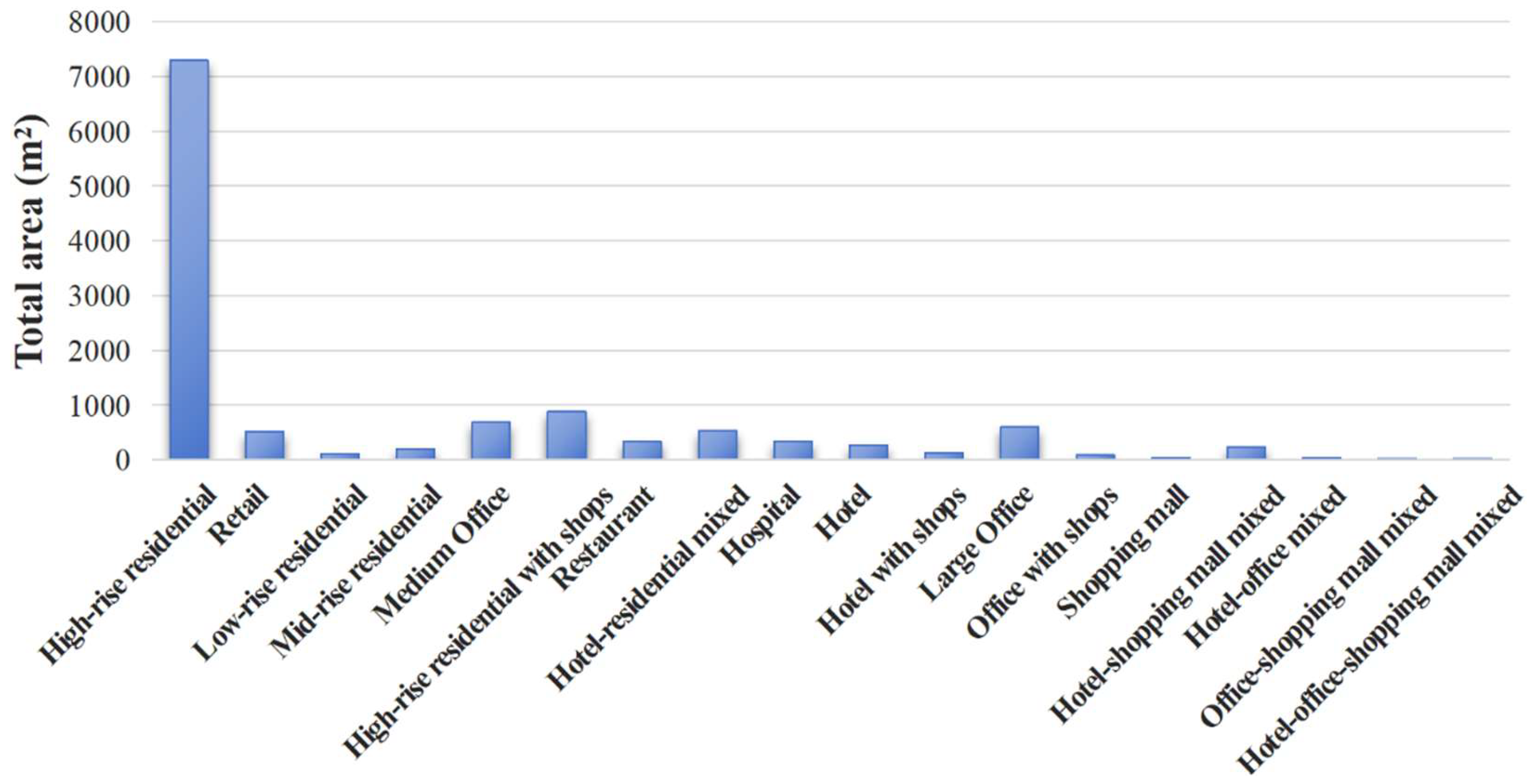
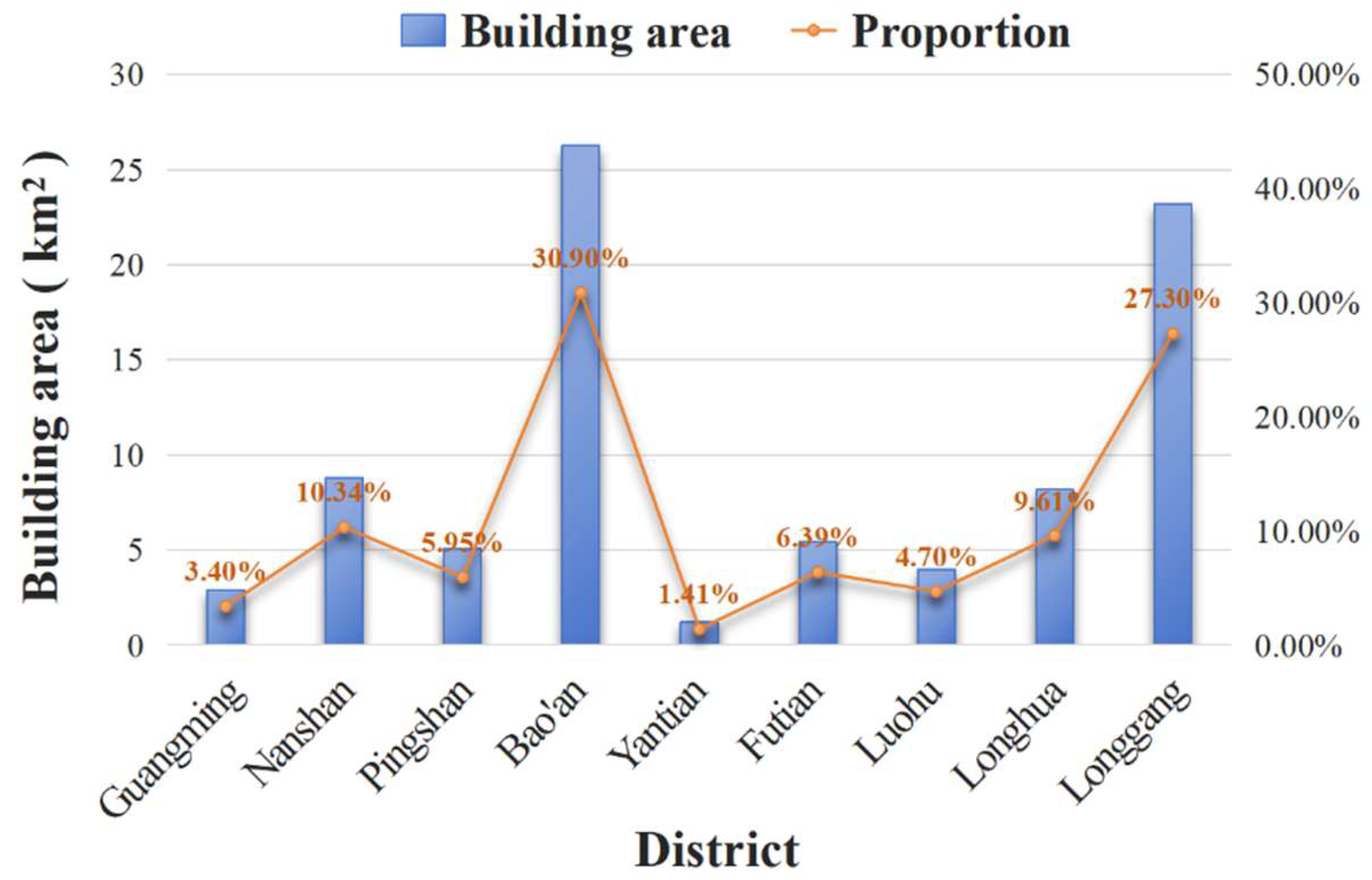
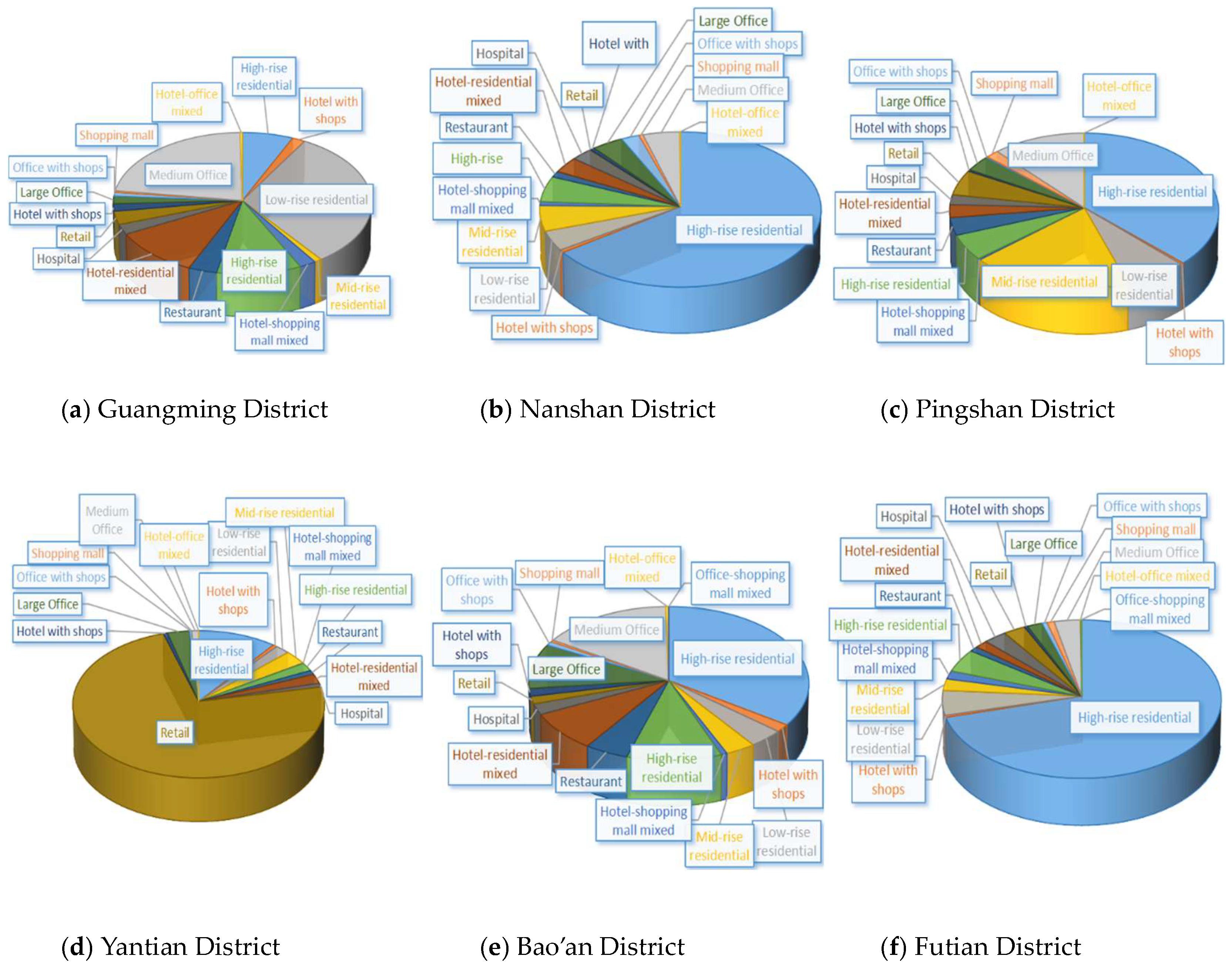
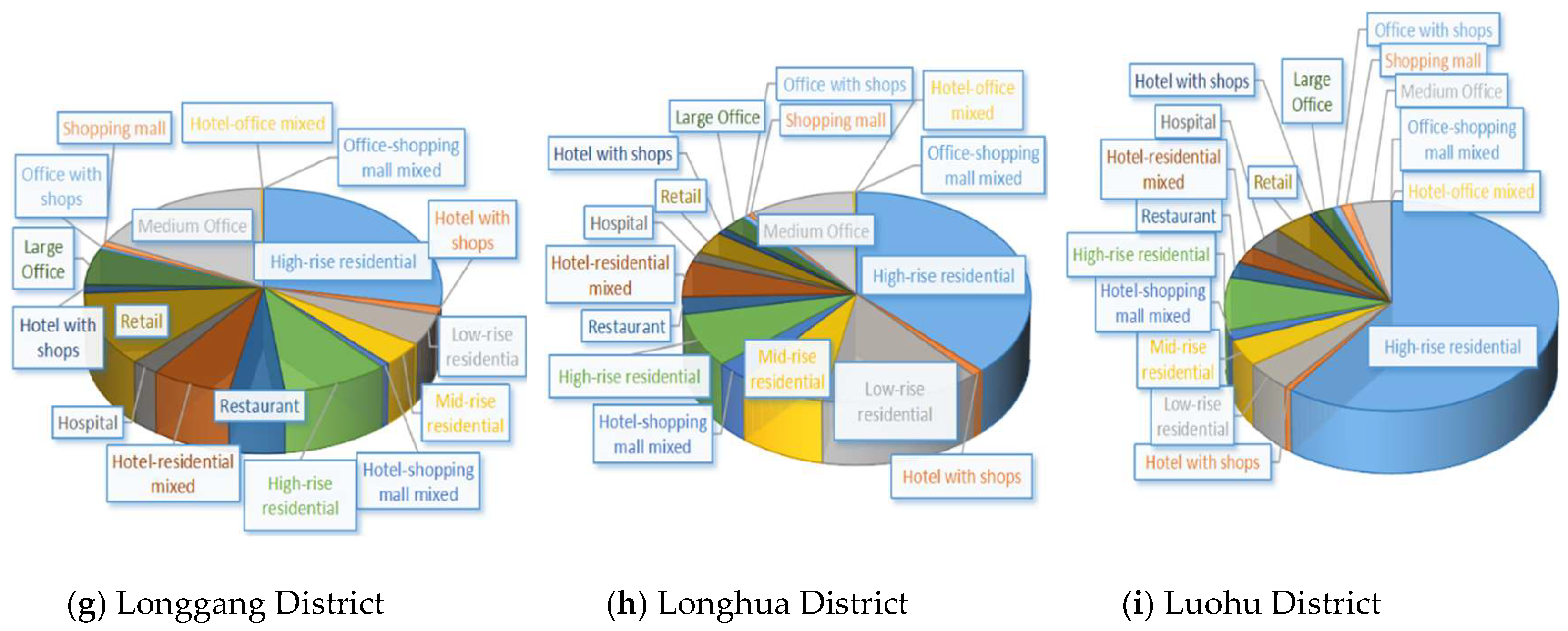




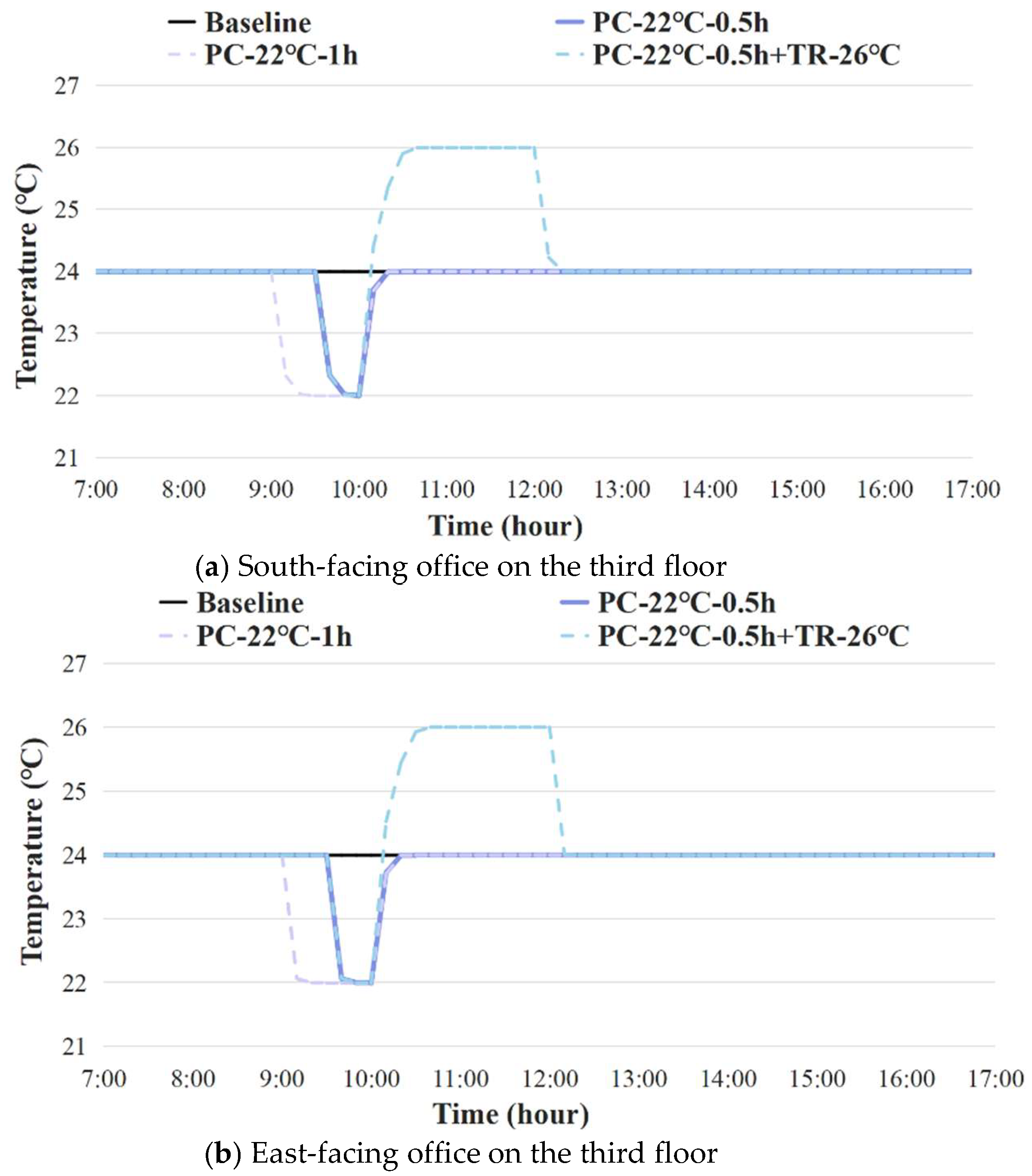
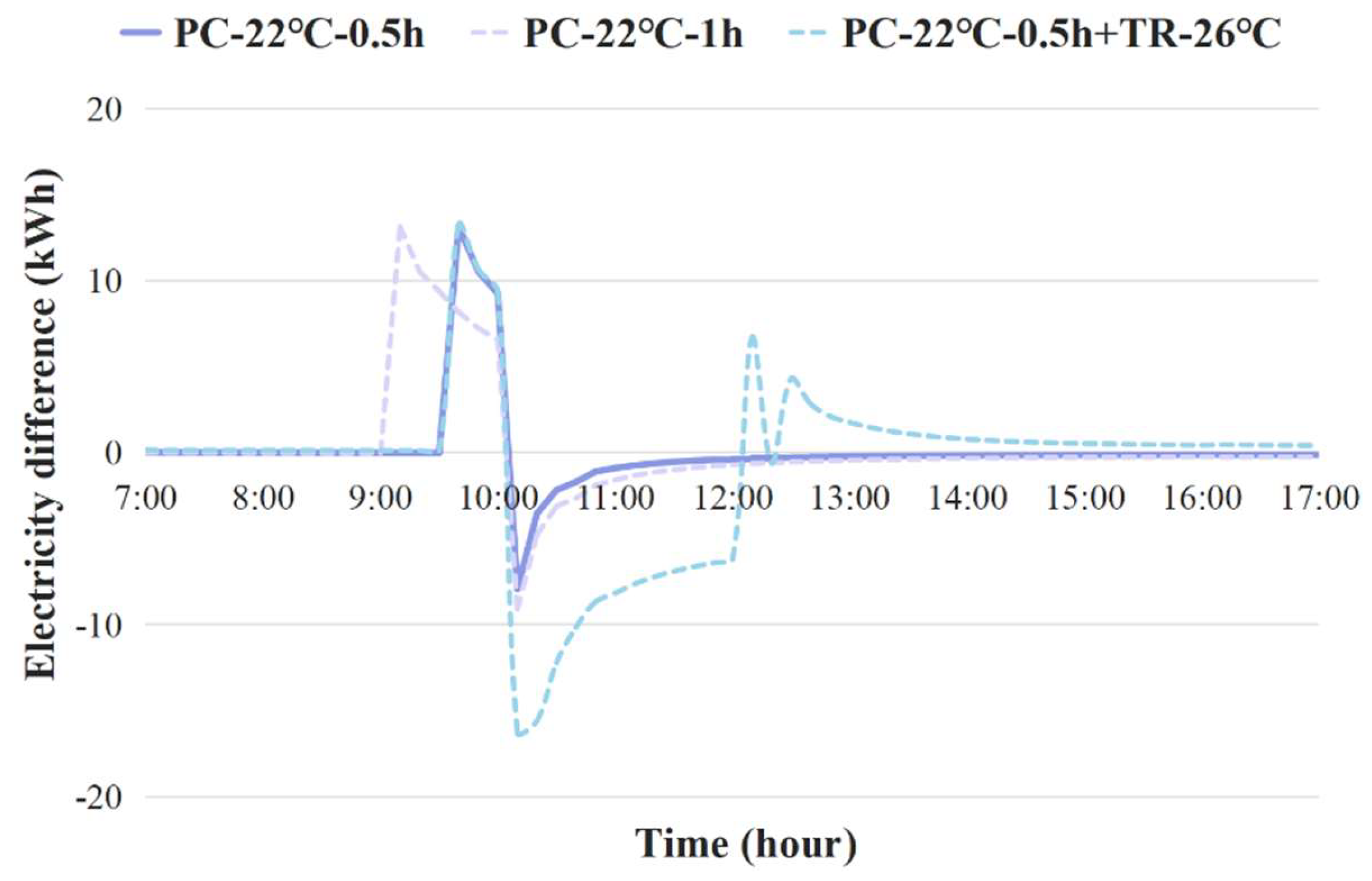
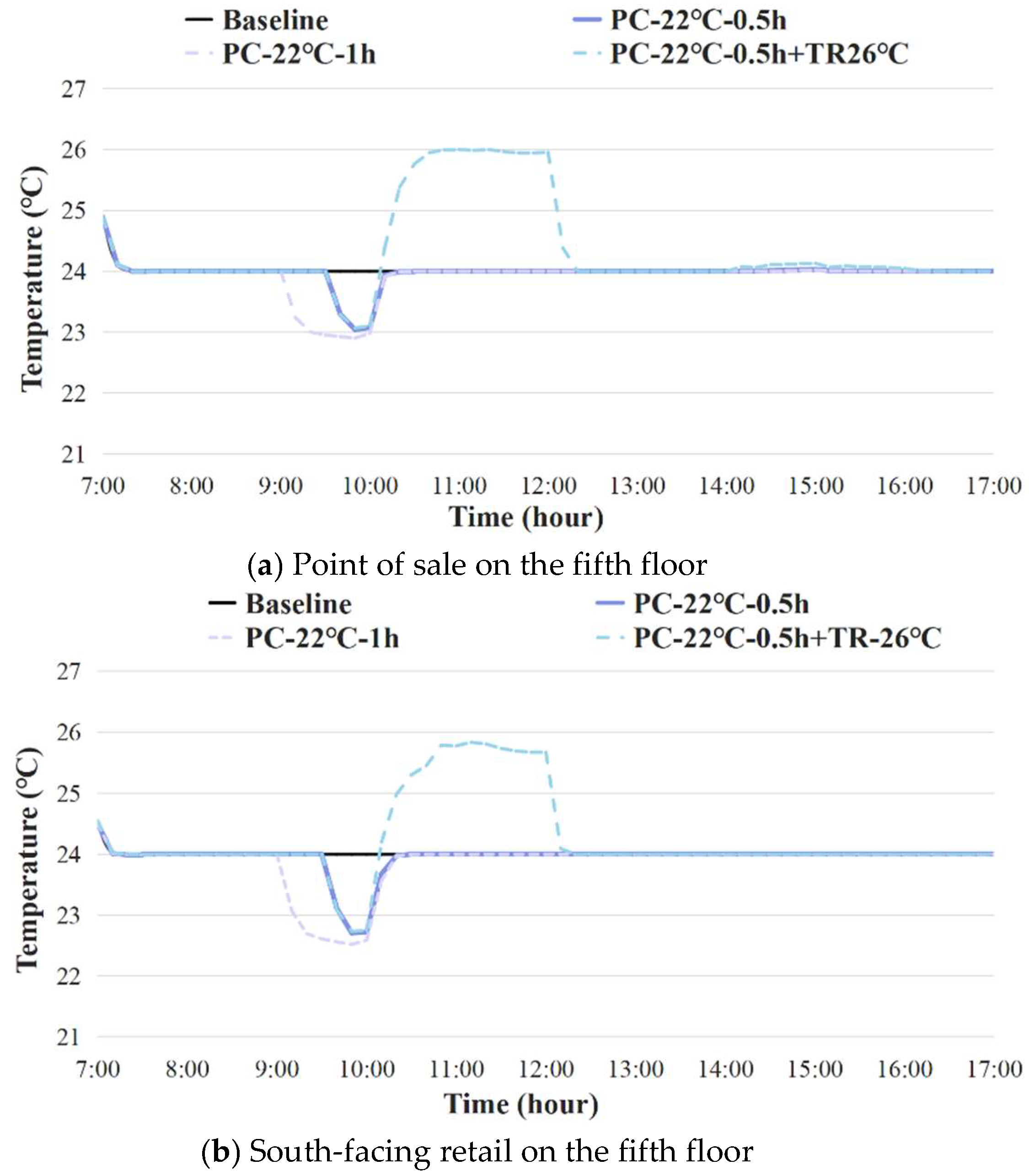
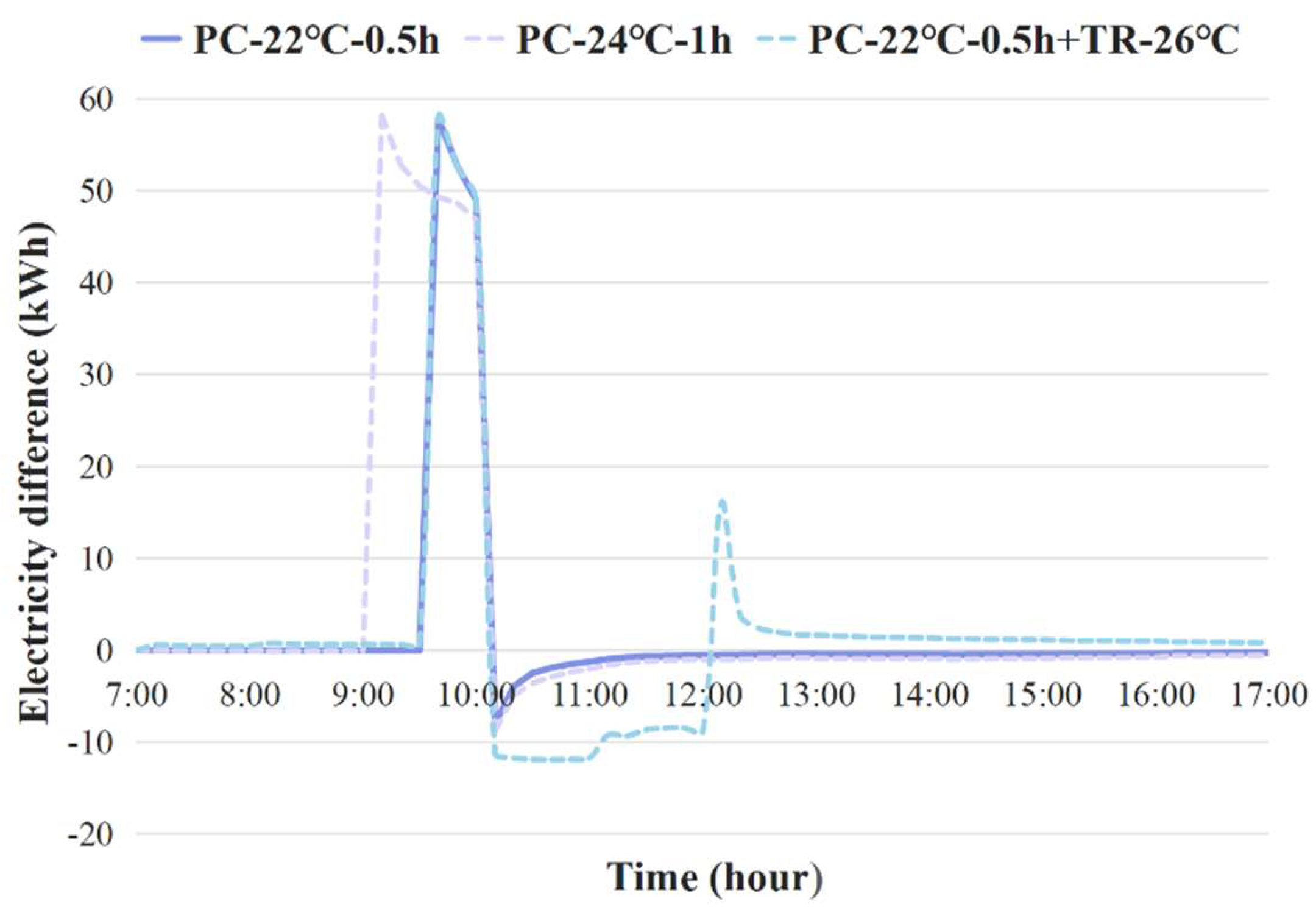
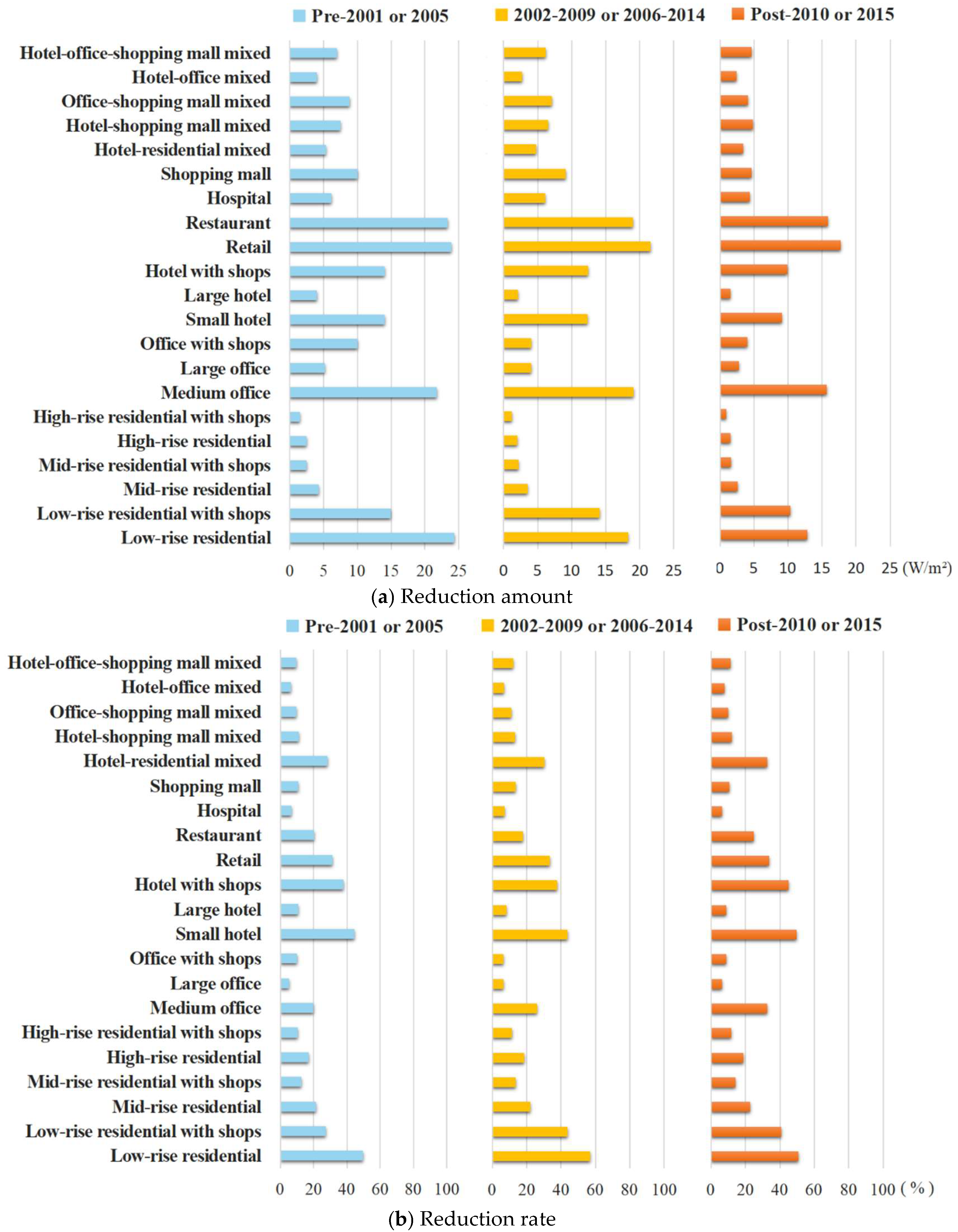

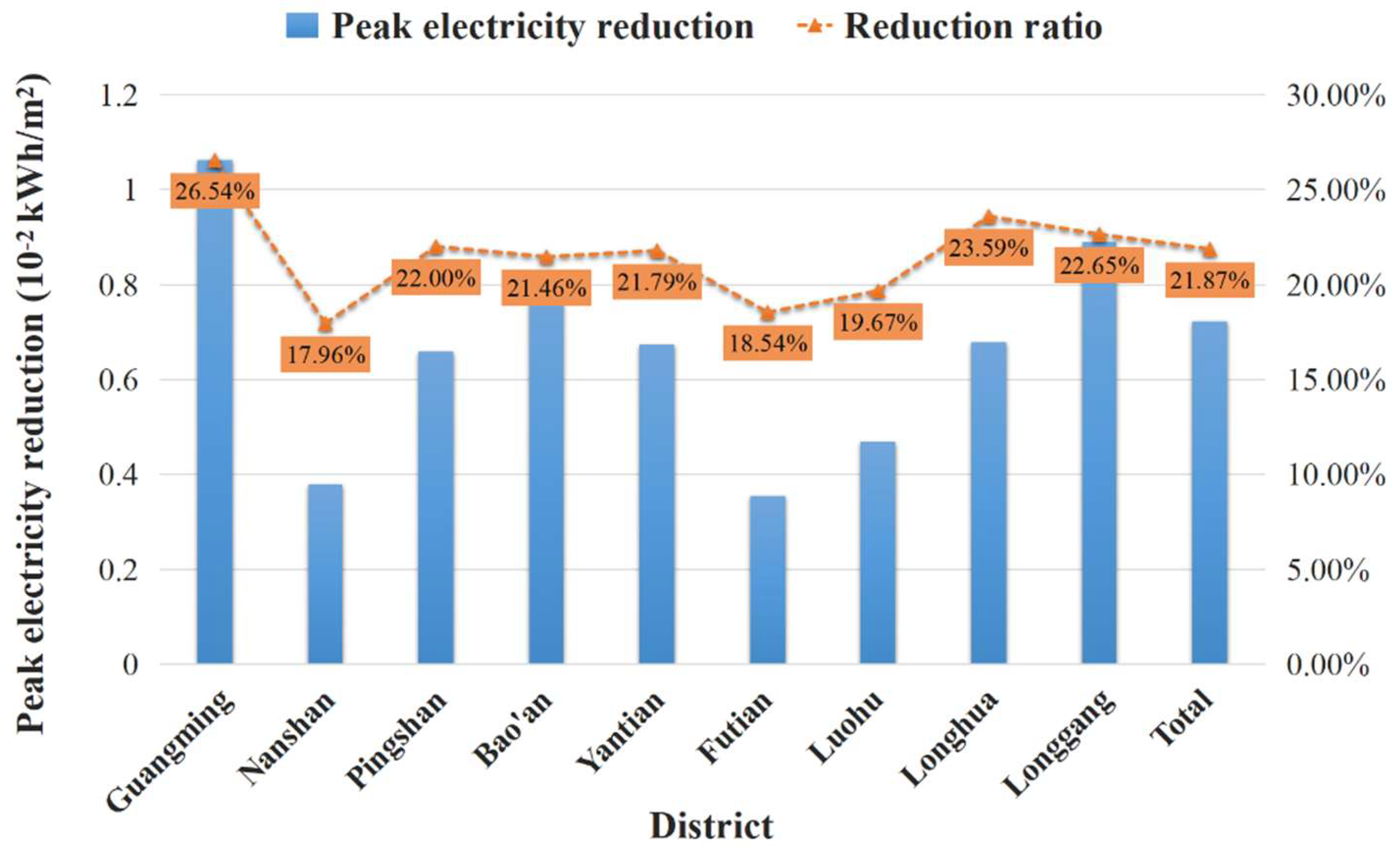
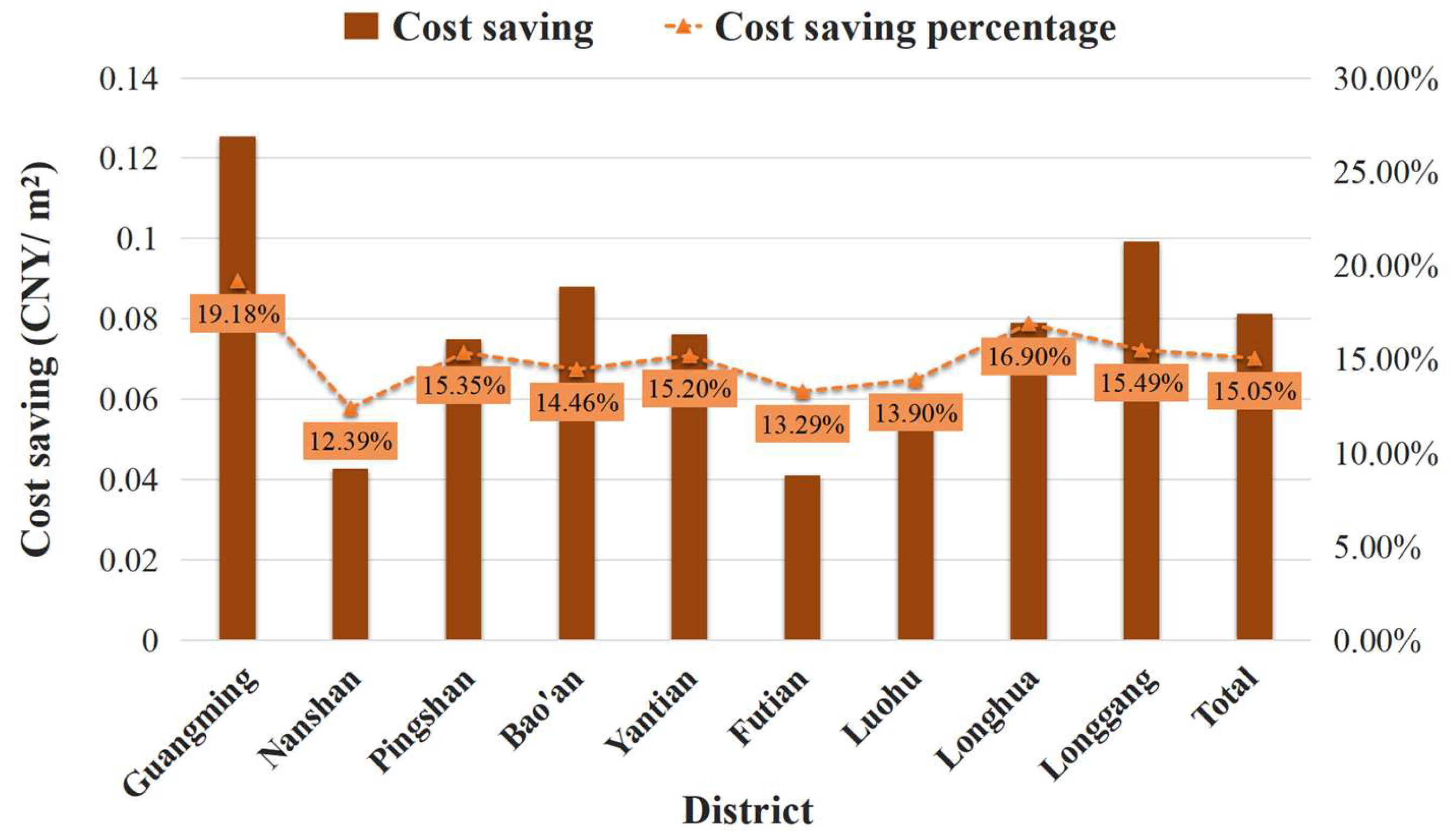
| Parameters | Pre-2001 | 2002–2009 | 2010–2021 |
|---|---|---|---|
| Exterior wall U-value (W/(m2⋅K)) | 1.96 | 1 | 0.8 |
| Roof U-value (W/(m2⋅K)) | 1.66 | 0.8 | 0.5 |
| Window U-value (W/(m2⋅K)) | 6.6 | 3.2 | 2.8 |
| Window SHGC | 0.85 | 0.48 | 0.34 |
| Parameters | Pre-2005 | 2006–2014 | 2015–2021 |
|---|---|---|---|
| Exterior wall U-value (W/(m2⋅K)) | 2 | 1 | 0.6 |
| Roof U-value (W/(m2⋅K)) | 1.5 | 0.7 | 0.4 |
| Window U-value (W/(m2⋅K)) | 6.4 | 3 | 2.6 |
| Window SHGC | 0.69 | 0.43 | 0.35 |
| Parameters | Residential Building | Hotel Guestroom | Office | Retail |
|---|---|---|---|---|
| Lighting power density (W/m2) | 7 | 15 | 11 | 12 |
| Equipment power density (W/m2) | 4.3 | 20 | 20 | 13 |
| Occupancy (person/m2) | 0.05 | 0.04 | 0.125 | 0.125 |
| Cooling/Heating setpoint (°C) | 26/18 | 25/22 | 26/20 | 24/21 |
| Building Type | Main Room Type | HVAC System | |
|---|---|---|---|
| Single-use | Low-rise residential | Apartment | Mini-split heat pump |
| Mid-rise residential | Apartment | Mini-split heat pump | |
| High-rise residential | Apartment | Mini-split heat pump | |
| Medium office | Office | Mini-split heat pump | |
| Large office | Office | Chiller and gas boiler | |
| Hotel | Guestroom | Chiller and gas boiler | |
| Retail | Retail | Mini-split heat pump | |
| Shopping mall | Retail | Chiller and gas boiler | |
| Restaurant | Dining room | Mini-split heat pump | |
| Mixed-use | High-rise residential with shops | Apartment, retail | Mini-split heat pump |
| Hotel-residential mixed | Guestroom, apartment | Mini-split heat pump | |
| Hotel with shops | Small guestroom, retail | Mini-split heat pump | |
| Office with shops | Office, retail | Chiller and gas boiler | |
| Hotel-shopping mall mixed | Large guestroom, retail | Chiller and gas boiler | |
| Hotel-office mixed | Guestroom, office | Chiller and gas boiler | |
| Office-shopping mall mixed | Office, retail | Chiller and gas boiler | |
| Hotel-office-shopping mall mixed | Guestroom, office, retail | Chiller and gas boiler | |
| Hospital | Patient room, office | Chiller and gas boiler | |
| Room Type | Whether to HVAC Control | Room Type | Whether to HVAC Control |
|---|---|---|---|
| Office | √ | Cafe | √ |
| Retail | √ | Exercise room | √ |
| Point of sale | √ | Conference room | √ |
| Banquet hall | √ | Guestroom | √ |
| Dining hall | √ | Apartment | √ |
| Kitchen | √ | Restroom | × |
| Laundry | √ | Basement | × |
| Lobby | √ | Storage | × |
| Operation Strategy | Medium Office | Shopping Mall | ||
|---|---|---|---|---|
| Cost Change (CNY) | Peak Load Change (10−2 kWh/m2) | Cost Change (CNY) | Peak Load Change (10−2 kWh/m2) | |
| PC-22 °C-1 h | +3.04 | −0.41 | +188.30 | −0.12 |
| PC-22 °C-0.5 h | −2.13 | −0.29 | +89.58 | −0.09 |
| PC-22 °C-0.5 h + TR-26 °C | −129.35 | −1.57 | −52.14 | −0.46 |
Disclaimer/Publisher’s Note: The statements, opinions and data contained in all publications are solely those of the individual author(s) and contributor(s) and not of MDPI and/or the editor(s). MDPI and/or the editor(s) disclaim responsibility for any injury to people or property resulting from any ideas, methods, instructions or products referred to in the content. |
© 2025 by the authors. Licensee MDPI, Basel, Switzerland. This article is an open access article distributed under the terms and conditions of the Creative Commons Attribution (CC BY) license (https://creativecommons.org/licenses/by/4.0/).
Share and Cite
Xu, A.; Song, C.; Zhao, W.; Chen, Y. Demand Flexibility of Pre-Cooling Strategies for City-Scale Buildings Through Urban Building Energy Modeling. Buildings 2025, 15, 1051. https://doi.org/10.3390/buildings15071051
Xu A, Song C, Zhao W, Chen Y. Demand Flexibility of Pre-Cooling Strategies for City-Scale Buildings Through Urban Building Energy Modeling. Buildings. 2025; 15(7):1051. https://doi.org/10.3390/buildings15071051
Chicago/Turabian StyleXu, Anni, Chengcheng Song, Wenxian Zhao, and Yixing Chen. 2025. "Demand Flexibility of Pre-Cooling Strategies for City-Scale Buildings Through Urban Building Energy Modeling" Buildings 15, no. 7: 1051. https://doi.org/10.3390/buildings15071051
APA StyleXu, A., Song, C., Zhao, W., & Chen, Y. (2025). Demand Flexibility of Pre-Cooling Strategies for City-Scale Buildings Through Urban Building Energy Modeling. Buildings, 15(7), 1051. https://doi.org/10.3390/buildings15071051







